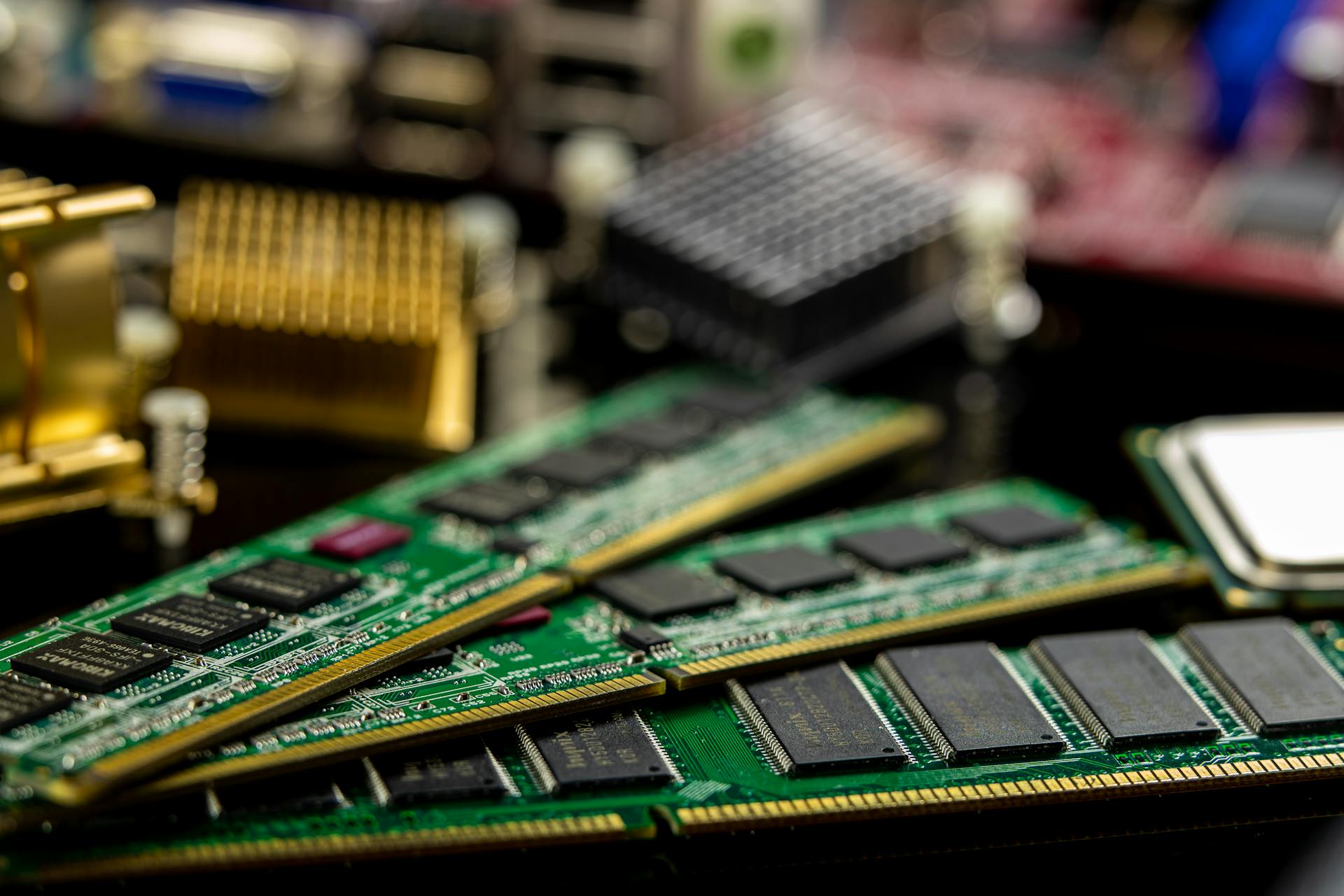
Computer vision and machine learning are two powerful technologies that have revolutionized the way we interact with computers.
Computer vision is a field of study that focuses on enabling computers to interpret and understand visual data from the world, such as images and videos. This technology has numerous applications in areas like self-driving cars, facial recognition, and medical diagnosis.
Machine learning, on the other hand, is a subset of artificial intelligence that involves training algorithms to learn from data and make predictions or decisions. It's a key component in many computer vision applications, allowing systems to improve their accuracy over time.
Machine learning can be used to improve the accuracy of computer vision systems, but it's not a replacement for the underlying computer vision technology.
For another approach, see: Data Labeling for Machine Learning
Concept and Functionality
Computer vision is a field of artificial intelligence that enables computers to understand and interpret visual data. It involves training computer algorithms to recognize objects, detect patterns, and interpret human gestures or emotions.
Computer vision employs algorithms and techniques to analyze images and videos, extracting meaningful information from them. This goal is to mimic human vision and enable machines to perceive, understand, and interpret visual data.
The applications of computer vision are far-reaching, including object recognition, image classification, facial recognition, and autonomous vehicles. Computer vision has various applications in automation, analytics, robotics, healthcare, and many other sectors.
Deep learning techniques, a part of machine learning, are commonly employed in computer vision tasks to improve accuracy through large datasets. This requires substantial amounts of labeled training data to achieve accurate results.
Here are some key aspects of computer vision:
- Recognizes objects
- Detects patterns
- Interprets human gestures or emotions
By combining computer vision with machine learning, computers not only analyze visual data but also learn from it, continuously improving their performance over time.
Use Cases
Computer vision is a subfield of machine learning that enables computers to interpret and understand visual data from images and videos. This technology has numerous applications in various industries, including transportation, security, and healthcare.
Facial recognition technology, for instance, utilizes computer vision for security and access control systems, enhancing safety measures. Medical imagery analysis also relies on computer vision to assist in the diagnosis of diseases.
In the field of transportation, computer vision plays a vital role in enabling autonomous vehicles to detect and identify objects on the road, ensuring safer journeys. This technology is also used in surveillance systems for object detection and tracking.
Some of the most notable use cases of machine learning in computer vision include:
- Facial recognition technology, which enhances security systems
- Medical imagery analysis to assist in the diagnosis of diseases
- In autonomous vehicles, visual data interpretation for real-time decision-making
- Surveillance systems benefit from object detection and tracking
- Social media platforms to improve image and video classification
Computer vision is also used in retail for inventory management and tracking customer behavior, optimizing business operations. In agriculture, computer vision assists in crop monitoring and yield estimation, improving the quality of the image and revolutionizing farming practices.
ViTs (Vision Transformers) are highly effective in image classification, object detection, and image segmentation. They excel in discerning fine-grained details within an image and accurately delineating object boundaries. This capability is particularly valuable in medical imaging, where precise segmentation can aid in diagnosing diseases and conditions.
Some of the applications of computer vision using machine learning include video tracking, autonomous vehicles, sports, and industrial monitoring and inspection. These applications showcase the potential of computer vision in various industries, from transportation to healthcare and retail.
A unique perspective: Computer Vision and Machine Learning
Machine Learning in Computer Vision
Machine learning is a pivotal component in advancing computer vision capabilities. It allows systems to learn and enhance their performance based on image data. By employing machine learning algorithms, computer vision systems can analyze large volumes of data and identify meaningful patterns within it.
Machine learning is used in computer vision in the interpreting device and interpretation stage. It offers effective methods for acquisition, image processing, and object focus. The application of machine learning in computer vision technology will become even more precise and efficient, leading to groundbreaking advancements in industries such as healthcare, autonomous vehicles, and surveillance.
Machine learning techniques often used in computer vision to train models to recognize and classify images. This relationship between the two fields is symbiotic, with computer vision providing valuable data for machine learning algorithms to learn from. Machine learning is a broader field that teaches computers to learn and make predictions based on data, making it a key component in advancing computer vision capabilities.
If this caught your attention, see: Supervised Learning Machine Learning Algorithms
What is Machine Learning?
Machine learning is a type of artificial intelligence that enables computers to learn from data without being explicitly programmed.
It's a crucial concept in computer vision, where machines can analyze and understand visual information from images and videos.
Machine learning algorithms can be trained on vast amounts of data, allowing them to improve their accuracy and make better predictions over time.
This process is often referred to as "training" the algorithm, which is similar to how a human learns from experience.
Machine learning models can be categorized into supervised, unsupervised, and reinforcement learning, each with its own strengths and weaknesses.
Supervised learning, for instance, requires a large dataset of labeled examples to train the model, which can be a challenge in certain applications.
Unsupervised learning, on the other hand, allows the model to discover patterns and relationships in the data without prior knowledge.
Reinforcement learning involves interacting with an environment to learn from trial and error, often used in robotics and game playing.
Broaden your view: Machine Learning Supervised vs Unsupervised Learning
How ML Improves
Machine learning has significantly improved computer vision capabilities, allowing systems to learn and enhance their performance based on image data. By employing machine learning algorithms, computer vision systems can analyze large volumes of data and identify meaningful patterns within it. This enables them to effectively handle intricate tasks like object recognition and image classification.
Machine learning in computer vision is a symbiotic relationship, with machine learning techniques often used to train models to recognize and classify images, and computer vision providing valuable data for machine learning algorithms to learn from.
One of the key benefits of machine learning in computer vision is its ability to improve the accuracy and efficiency of tasks such as object detection, image recognition, and facial recognition. For instance, machine learning algorithms can be used to detect objects in images and videos, even in situations where the objects are partially occluded or in complex backgrounds.
Here are some ways machine learning improves computer vision:
- Object recognition
- Image classification
- Facial recognition
- Object detection
- Image analysis
These improvements have far-reaching implications for various industries, including healthcare, autonomous vehicles, and surveillance. By leveraging machine learning, computer vision systems can become more precise and efficient, leading to groundbreaking advancements in these fields.
Key Features of Stable Diffusion V2
Stable Diffusion V2 incorporates robust text-to-image models that utilize a new text encoder (OpenCLIP) to enhance the quality of generated images.
These models can produce images with resolutions like 512×512 pixels and 768×768 pixels, offering significant improvements over previous versions.
A notable addition in V2 is the Upscaler Diffusion model that can increase the resolution of images by a factor of 4.
This feature allows for converting low-resolution images into much higher-resolution versions, up to 2048×2048 pixels or more when combined with text-to-image models.
The updated text-guided inpainting model in Stable Diffusion V2 allows for intelligent and quick modification of parts of an image.
This makes it easier to edit and enhance images with high precision.
Stable Diffusion V2 can generate high-quality, high-resolution images from textual descriptions, representing a leap forward in computer-generated imagery.
The model's enhanced capabilities have practical applications in fields like digital art, graphic design, and content creation.
The advanced inpainting capabilities of Stable Diffusion V2 allow for more sophisticated image editing and manipulation.
This can have practical applications in fields like advertising, where quick and intelligent image modifications are often required.
Stable Diffusion V2 becomes accessible to a broader audience by optimizing the model for single GPU use.
This democratization could lead to more collaborative and innovative uses of AI in visual tasks, fostering a community-driven approach to AI development.
Technological Landscape and History
Computer vision has its roots in the 1960s when researchers first attempted to enable computers to interpret visual data.
The journey began with simple tasks like distinguishing shapes and progressed to more complex functions. This laid the groundwork for modern computer vision, enabling computers to perform tasks ranging from object detection to complex scene understanding.
The first algorithm for digital image processing was developed in the early 1970s, marking a significant milestone in the evolution of computer vision.
AI Data Companies in the Technological Landscape
AI data companies play a critical role in the technological landscape by providing high-quality training data for computer vision and machine learning algorithms.
They specialize in collecting, annotating, and curating extensive datasets that enhance the accuracy and diversity of AI models.
These companies empower businesses to leverage the power of AI technologies, enabling organizations to make informed decisions and enhance operational efficiency.
By offering access to reliable and relevant data, AI data companies drive innovation across various industries, including healthcare, finance, retail, and more.
With their assistance, businesses can unlock valuable insights and gain a competitive edge in today's rapidly evolving digital landscape.
AI data companies provide the foundation for businesses to unlock the full potential of AI technologies.
A unique perspective: Top Machine Learning Applications at Fin Tech Companies
History of Traditional CV
Computer vision has its roots in the 1960s when researchers first attempted to enable computers to interpret visual data.
The journey of computer vision began with simple tasks like distinguishing shapes. Researchers made significant progress in the early 1970s with the development of the first algorithm for digital image processing.
The early advancements in feature detection methods enabled computers to perform tasks ranging from object detection to complex scene understanding.
OpenCV Dominance
OpenCV has been a key player in computer vision since the late 1990s, offering over 2500 optimized algorithms that have made it a favorite in academia and industry.
Its ease of use and versatility in tasks like facial recognition and traffic monitoring have made it a go-to choice for many professionals.
The library's popularity can be attributed to its ability to handle real-time applications with ease.
OpenCV's algorithms have been used in a wide range of applications, from surveillance systems to medical imaging.
The field of computer vision has evolved significantly with the advent of deep learning, shifting from traditional, rule-based methods to more advanced and adaptable systems.
Convolutional Neural Networks (CNNs) have been particularly effective in overcoming the limitations of earlier techniques like thresholding and edge detection.
These traditional methods had limitations in complex scenarios, but deep learning has allowed for more accurate and versatile image recognition and classification.
Curious to learn more? Check out: Is Transfer Learning Different than Deep Learning
Deep Learning and Advanced Techniques
Deep learning has revolutionized the field of computer vision, particularly in image classification tasks. ResNet-50 is a breakthrough model with 50 layers deep, a significant increase compared to previous models.
ResNet-50 is a variant of the ResNet model, which has been widely adopted for its ability to handle complex image classification tasks. This model has been a game-changer in the field of deep learning for computer vision.
Curious to learn more? Check out: Grokking Deep Learning
Deep
Deep learning models like ResNet-50 have revolutionized the field of computer vision, particularly in image classification tasks.
ResNet-50 contains 50 layers deep, a significant increase compared to previous models, which allows it to learn more complex features at various levels.
This depth enables the network to achieve excellent accuracy on various image classification benchmarks like ImageNet, making it a popular choice in the research community and industry.
ResNet-50's residual blocks address the vanishing gradient problem by allowing the model to skip one or more layers through skip connections, making it possible to train much deeper networks.
Thanks to these residual blocks, ResNet-50 can be trained much deeper without suffering from the vanishing gradient problem, which is a common issue in deep networks.
Despite its depth, ResNet-50 is relatively efficient in terms of computational resources compared to other deep models, making it a versatile and efficient choice for various real-world applications.
Transformers
Transformers are a type of deep learning model that's revolutionizing the way we process images.
By applying the transformer architecture to images, Vision Transformers (ViTs) can process images more efficiently and accurately than traditional Convolutional Neural Networks (CNNs).
One of the key features of ViTs is their ability to divide an image into patches, which are then linearly embedded, treating the image as a sequence of patches.
This patch-based approach allows ViTs to focus on critical regions within the image and understand the relationships between different patches.
ViTs use a multi-head attention network to process these image patches, which enables them to understand the spatial relationship of image parts.
Layer normalization is also a crucial feature of ViTs, ensuring stable training by normalizing the inputs across the layers.
The Vision Transformer model has demonstrated significant improvements in accuracy and computational efficiency over traditional CNNs in image classification tasks.
ViTs are increasingly being used in a variety of real-world applications across different fields due to their efficiency and accuracy in handling complex image data.
The transformer architecture used in ViTs marks a significant advancement in the field of computer vision, offering a powerful alternative to conventional CNNs.
Stable Diffusion V2: Key Features
Stable Diffusion V2 has advanced text-to-image models that utilize a new text encoder called OpenCLIP, which enhances the quality of generated images.
These models can produce images with resolutions like 512×512 pixels and 768×768 pixels, offering significant improvements over previous versions.
The Upscaler Diffusion model in V2 can increase the resolution of images by a factor of 4, allowing for converting low-resolution images into much higher-resolution versions.
With a combination of text-to-image models and the Upscaler Diffusion model, images can be upscaled to resolutions of up to 2048×2048 pixels or more.
The updated text-guided inpainting model in Stable Diffusion V2 allows for intelligent and quick modification of parts of an image.
This makes it easier to edit and enhance images with high precision, which can have practical applications in fields like advertising.
Stable Diffusion V2's advanced features enable more complex and creative applications, such as experimenting with depth information and high-resolution outputs.
This can push the boundaries of digital creativity and open up new avenues for artists and designers.
Challenges and Future Directions
Computer vision is a challenging field, and it's not just because it's hard to make computers do it. Inventing a machine that sees like we do is a deceptively difficult task.
Studying biological vision requires an understanding of the perception organs like the eyes, as well as the interpretation of the perception within the brain. This is a long way from being fully understood.
Many popular computer vision applications involve trying to recognize things in photographs, such as object classification, object identification, and object detection. These tasks are not as simple as they sound.
Object detection, for example, involves finding the objects in a photograph, which can be a complex task, especially when dealing with cluttered or noisy images.
Computer vision also involves other methods of analysis, such as video motion analysis, image segmentation, scene reconstruction, and image restoration. These tasks require sophisticated algorithms and machine learning techniques.
Some of the specific challenges in computer vision include:
- Object Classification: What broad category of object is in this photograph?
- Object Identification: Which type of a given object is in this photograph?
- Object Verification: Is the object in the photograph?
- Object Detection: Where are the objects in the photograph?
- Object Landmark Detection: What are the key points for the object in the photograph?
- Object Segmentation: What pixels belong to the object in the image?
- Object Recognition: What objects are in this photograph and where are they?
These tasks are just a few examples of the many challenges in computer vision, and they require a deep understanding of the underlying technology and algorithms.
Frequently Asked Questions
Is CV a part of ML?
CV is not entirely a part of ML, as some techniques like homography are based on mathematical calculations rather than machine learning algorithms. However, learning-based computer vision is indeed a subfield of machine learning, leveraging ML to analyze and understand visual data.
Sources
- https://www.atltranslate.com/ai/blog/computer-vision-vs-machine-learning-explained
- https://opencv.org/blog/deep-learning-with-computer-vision/
- https://www.weka.io/blog/ai-ml/computer-vision-vs-machine-learning/
- https://fullscale.io/blog/machine-learning-computer-vision/
- https://towardsdatascience.com/everything-you-ever-wanted-to-know-about-computer-vision-heres-a-look-why-it-s-so-awesome-e8a58dfb641e
Featured Images: pexels.com


